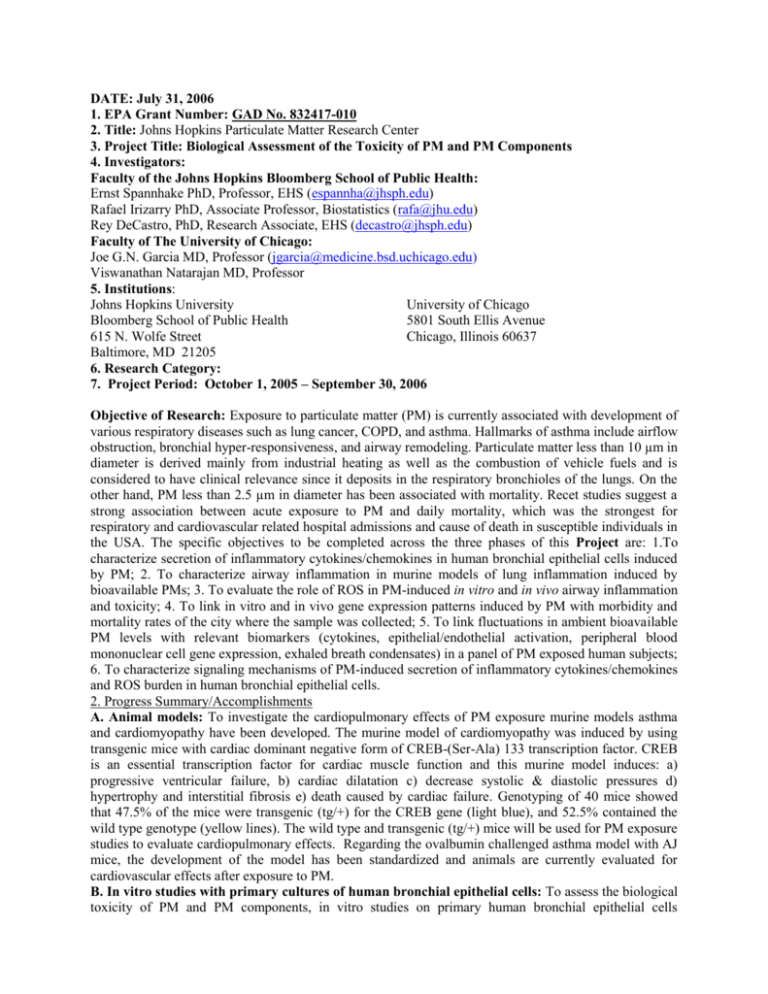Year1 Progress Report - Johns Hopkins Bloomberg School of Public
advertisement

DATE: July 31, 2006 1. EPA Grant Number: GAD No. 832417-010 2. Title: Johns Hopkins Particulate Matter Research Center 3. Project Title: Biological Assessment of the Toxicity of PM and PM Components 4. Investigators: Faculty of the Johns Hopkins Bloomberg School of Public Health: Ernst Spannhake PhD, Professor, EHS (espannha@jhsph.edu) Rafael Irizarry PhD, Associate Professor, Biostatistics (rafa@jhu.edu) Rey DeCastro, PhD, Research Associate, EHS (decastro@jhsph.edu) Faculty of The University of Chicago: Joe G.N. Garcia MD, Professor (jgarcia@medicine.bsd.uchicago.edu) Viswanathan Natarajan MD, Professor 5. Institutions: Johns Hopkins University University of Chicago Bloomberg School of Public Health 5801 South Ellis Avenue 615 N. Wolfe Street Chicago, Illinois 60637 Baltimore, MD 21205 6. Research Category: 7. Project Period: October 1, 2005 – September 30, 2006 Objective of Research: Exposure to particulate matter (PM) is currently associated with development of various respiratory diseases such as lung cancer, COPD, and asthma. Hallmarks of asthma include airflow obstruction, bronchial hyper-responsiveness, and airway remodeling. Particulate matter less than 10 µm in diameter is derived mainly from industrial heating as well as the combustion of vehicle fuels and is considered to have clinical relevance since it deposits in the respiratory bronchioles of the lungs. On the other hand, PM less than 2.5 µm in diameter has been associated with mortality. Recet studies suggest a strong association between acute exposure to PM and daily mortality, which was the strongest for respiratory and cardiovascular related hospital admissions and cause of death in susceptible individuals in the USA. The specific objectives to be completed across the three phases of this Project are: 1.To characterize secretion of inflammatory cytokines/chemokines in human bronchial epithelial cells induced by PM; 2. To characterize airway inflammation in murine models of lung inflammation induced by bioavailable PMs; 3. To evaluate the role of ROS in PM-induced in vitro and in vivo airway inflammation and toxicity; 4. To link in vitro and in vivo gene expression patterns induced by PM with morbidity and mortality rates of the city where the sample was collected; 5. To link fluctuations in ambient bioavailable PM levels with relevant biomarkers (cytokines, epithelial/endothelial activation, peripheral blood mononuclear cell gene expression, exhaled breath condensates) in a panel of PM exposed human subjects; 6. To characterize signaling mechanisms of PM-induced secretion of inflammatory cytokines/chemokines and ROS burden in human bronchial epithelial cells. 2. Progress Summary/Accomplishments A. Animal models: To investigate the cardiopulmonary effects of PM exposure murine models asthma and cardiomyopathy have been developed. The murine model of cardiomyopathy was induced by using transgenic mice with cardiac dominant negative form of CREB-(Ser-Ala) 133 transcription factor. CREB is an essential transcription factor for cardiac muscle function and this murine model induces: a) progressive ventricular failure, b) cardiac dilatation c) decrease systolic & diastolic pressures d) hypertrophy and interstitial fibrosis e) death caused by cardiac failure. Genotyping of 40 mice showed that 47.5% of the mice were transgenic (tg/+) for the CREB gene (light blue), and 52.5% contained the wild type genotype (yellow lines). The wild type and transgenic (tg/+) mice will be used for PM exposure studies to evaluate cardiopulmonary effects. Regarding the ovalbumin challenged asthma model with AJ mice, the development of the model has been standardized and animals are currently evaluated for cardiovascular effects after exposure to PM. B. In vitro studies with primary cultures of human bronchial epithelial cells: To assess the biological toxicity of PM and PM components, in vitro studies on primary human bronchial epithelial cells (HBEpCs) grown submerged on plastic dishes (poorly differentiated) and cells cultured in an air-liquid interface (ALI) for 21 days in the presence of retinoic acid (highly differentiated, ciliated and mucin secreting cell) were used. a) Preparation of PM suspension for in vitro studies: A suspension of PM 10 (1 mg/ml) in serum-free BEBM medium was prepared, sonicated in a bath type sonicator for 2min and the suspension was rotated in shaker for 60 min at RT. The PM suspension was either used directly or centrifuged at 2,000 x g for 10 min to obtain a pellet and a soluble fraction. The pellet was resuspended in serum free BEBM to give a final concentration of 1 mg/ml. The submerged or ALI cells were exposed to the suspension solution containing the PM10 or the soluble fraction devoid of the particles or the resuspended pellet minus the soluble fraction for varying time periods or different concentrations of PM to assess cytotoxicity, total ROS and secretion of cytokines. b) Cytotoxicity assessments: Differentiated HBEpCs grown in ALI were exposed apically for 3, 15 and 24 h to 10, 50 and 100 µg/ml of PM 10 suspension (PM collected from Baltimore under Project 2) in a total volume of 0.5 ml on the apical side and 1ml on the basolateral side. Microscopic evaluation of the cells indicated no gross alterations in cellular morphology after exposure to different levels of PM 10 at 3 or 15 or 24h. The medium from apical and basolateral sides were analyzed for LDH release using a commercial kit. Treatment of cells with PM 10 (10, 25 and 50 µg/ml) for 3, 15 and 24 h, as compared to controls had no effect on release of LDH (a marker for cellular cytotoxicity). c) Secretion of cytokines and ROS by PM 10 in submerged cells: HBEpCs (~90% confluence) in submerged cultures released only small amounts of GM-CSF or IL-6 or IL-8 or IL-1β in a 24 h time period in the absence of added PM 10. Exposure of cells to PM 10 for 24 h released significant quantities of all the cytokines, which was dose-dependent. The order of secretion after exposure to PM 10 for 24 h was Il-8 > GM-CSF> IL-6 > IL-1β. In parallel experiments total ROS generated by control and PM treated cells was determined by DCFDA oxidation/immunofluorescence microscopy or hydrogen peroxide release using Amplex Red assay. Our preliminary results show that exposure of submerged HBEpCs to 100 µg of PM 10 enhanced total ROS production after 15, 30 and 60 min periods. At 60 min, ~3 fold increase in ROS production, as measured by DCFDA oxidation, compared to control cells was observed. d) Secretion of cytokines and ROS by PM 10 in ALI grown cells: In non-treated ALI cells, high levels of GM-CSF, IL-6, IL-8 and IL-1β were secreted into the apical side and very little in the basolateral side. Treatment of cells with PM 10 (50 µg/ml) for 24 h significantly increased IL-6 secretion into the apical side (2 to 3 fold increase) with no release into the basolateral side. e) Soluble vs. insoluble components of PM 10 in ROS production: Submerged HBEpCs were exposed to total PM suspension (100 µg/ml) or equivalent volume of soluble fraction or resuspended pellet fraction. Our preliminary results show that similar amounts of ROS are generated by the total PM suspension or soluble fraction or by resuspended pellet minus soluble components. Publications: 1. Release of cytokines and reactive oxygen species by particulate matter in submerged and air-liquid interface human bronchial epithelial cells. (Manuscript in Preparation). 2. Effect of particulate matter on cardiopulmonary functions in a murine model of cardiac hypertrophy (Manuscript in Preparation). Future Activities: Future studies will be directed to assess cardiac functions by non-invasive methods (echocardiography), heart rate variability and mortality to PM exposure (0.5 mg/mouse) for 10-12 weeks in the two murine models. Hearts will be collected for histopathologic findings and for Microarray analysis for looking at gene expression changes between PM-exposed, CREB deficient mice, ovalbumin challenged mice and wild type controls. In vitro studies using submerged and ALI cultures will be assessed for various cytokines and ROS production with PM collected from different locations and during different times of the year (from Project 2). Supplemental Key Words: Differentiated and non-differentiated airway cells; ROS; particulate matter, murine models; cardiopulmonary functions; cytotoxicity; cytokines.






